Management 1: Analysis of Design Thinking and Practice
VerifiedAdded on 2023/01/18
|11
|3130
|58
Report
AI Summary
This report provides a comprehensive analysis of design thinking in a management context, focusing on the author's personal learning and experiences. It explores the importance of design thinking for modern managers, particularly in the context of globalization and its impact on business operations. The report delves into the practical application of design thinking methods, including visualization, journey mapping, value chain analysis, and brainstorming, and their influence on promoting creative thinking within organizations. It also presents a self-analysis of the author's strengths and weaknesses in promoting design thinking, along with an action plan for development. The report highlights the significance of design thinking in fostering employee involvement, improving problem-solving capabilities, and adapting to the changing business environment. The author's insights provide a valuable perspective on the practical application of design thinking principles in leadership and management.
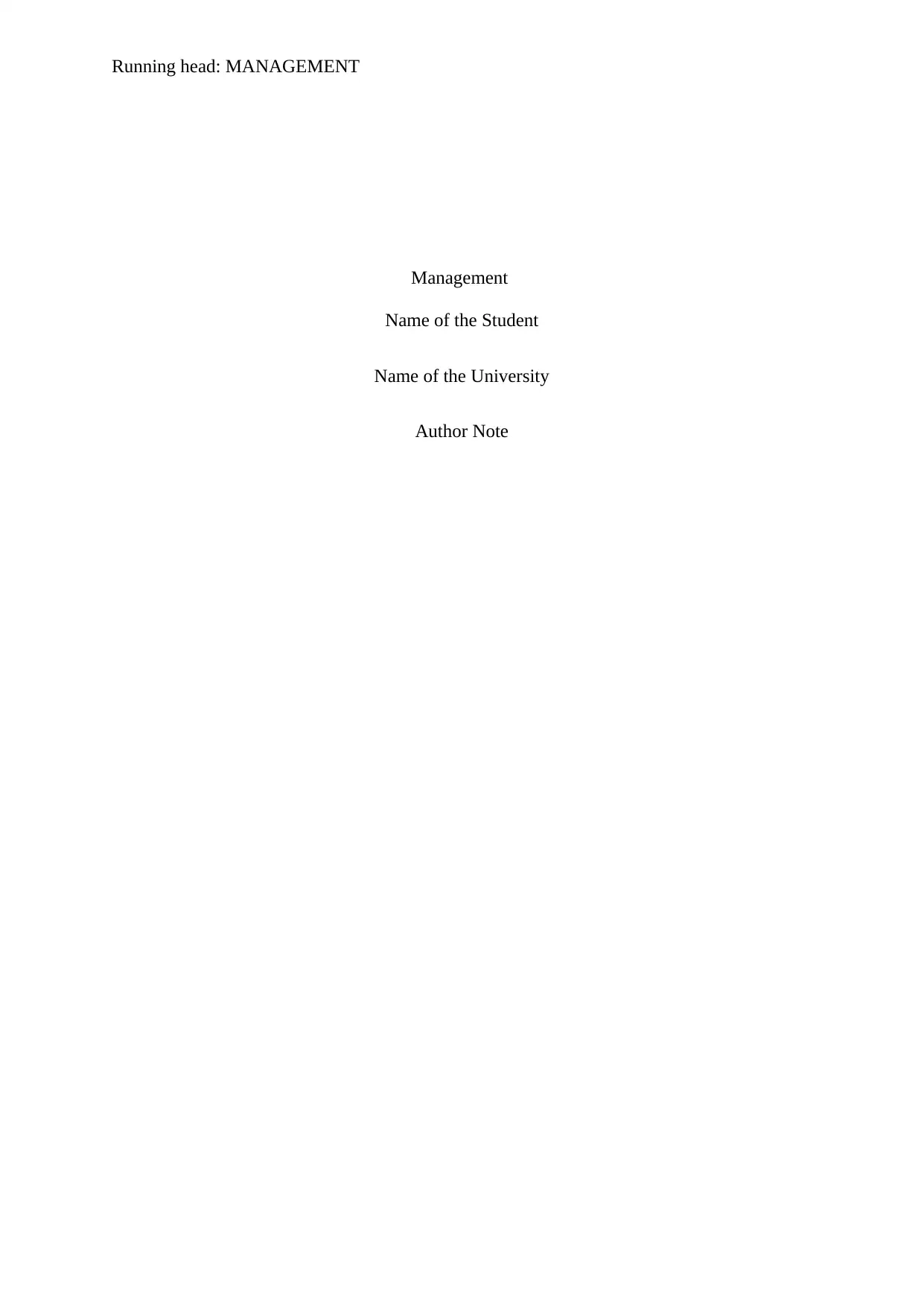
Running head: MANAGEMENT
Management
Name of the Student
Name of the University
Author Note
Management
Name of the Student
Name of the University
Author Note
Paraphrase This Document
Need a fresh take? Get an instant paraphrase of this document with our AI Paraphraser
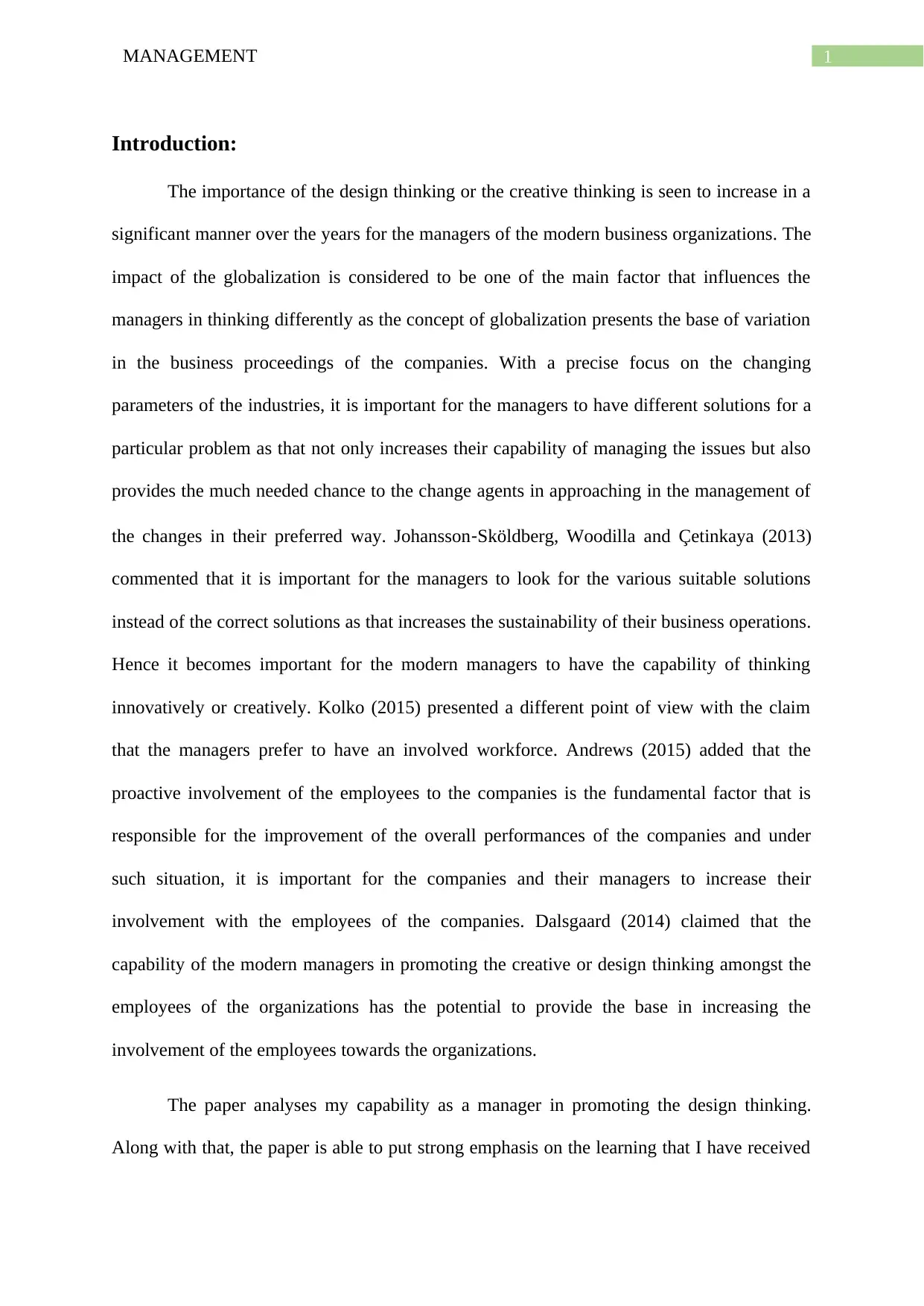
1MANAGEMENT
Introduction:
The importance of the design thinking or the creative thinking is seen to increase in a
significant manner over the years for the managers of the modern business organizations. The
impact of the globalization is considered to be one of the main factor that influences the
managers in thinking differently as the concept of globalization presents the base of variation
in the business proceedings of the companies. With a precise focus on the changing
parameters of the industries, it is important for the managers to have different solutions for a
particular problem as that not only increases their capability of managing the issues but also
provides the much needed chance to the change agents in approaching in the management of
the changes in their preferred way. Johansson‐Sköldberg, Woodilla and Çetinkaya (2013)
commented that it is important for the managers to look for the various suitable solutions
instead of the correct solutions as that increases the sustainability of their business operations.
Hence it becomes important for the modern managers to have the capability of thinking
innovatively or creatively. Kolko (2015) presented a different point of view with the claim
that the managers prefer to have an involved workforce. Andrews (2015) added that the
proactive involvement of the employees to the companies is the fundamental factor that is
responsible for the improvement of the overall performances of the companies and under
such situation, it is important for the companies and their managers to increase their
involvement with the employees of the companies. Dalsgaard (2014) claimed that the
capability of the modern managers in promoting the creative or design thinking amongst the
employees of the organizations has the potential to provide the base in increasing the
involvement of the employees towards the organizations.
The paper analyses my capability as a manager in promoting the design thinking.
Along with that, the paper is able to put strong emphasis on the learning that I have received
Introduction:
The importance of the design thinking or the creative thinking is seen to increase in a
significant manner over the years for the managers of the modern business organizations. The
impact of the globalization is considered to be one of the main factor that influences the
managers in thinking differently as the concept of globalization presents the base of variation
in the business proceedings of the companies. With a precise focus on the changing
parameters of the industries, it is important for the managers to have different solutions for a
particular problem as that not only increases their capability of managing the issues but also
provides the much needed chance to the change agents in approaching in the management of
the changes in their preferred way. Johansson‐Sköldberg, Woodilla and Çetinkaya (2013)
commented that it is important for the managers to look for the various suitable solutions
instead of the correct solutions as that increases the sustainability of their business operations.
Hence it becomes important for the modern managers to have the capability of thinking
innovatively or creatively. Kolko (2015) presented a different point of view with the claim
that the managers prefer to have an involved workforce. Andrews (2015) added that the
proactive involvement of the employees to the companies is the fundamental factor that is
responsible for the improvement of the overall performances of the companies and under
such situation, it is important for the companies and their managers to increase their
involvement with the employees of the companies. Dalsgaard (2014) claimed that the
capability of the modern managers in promoting the creative or design thinking amongst the
employees of the organizations has the potential to provide the base in increasing the
involvement of the employees towards the organizations.
The paper analyses my capability as a manager in promoting the design thinking.
Along with that, the paper is able to put strong emphasis on the learning that I have received
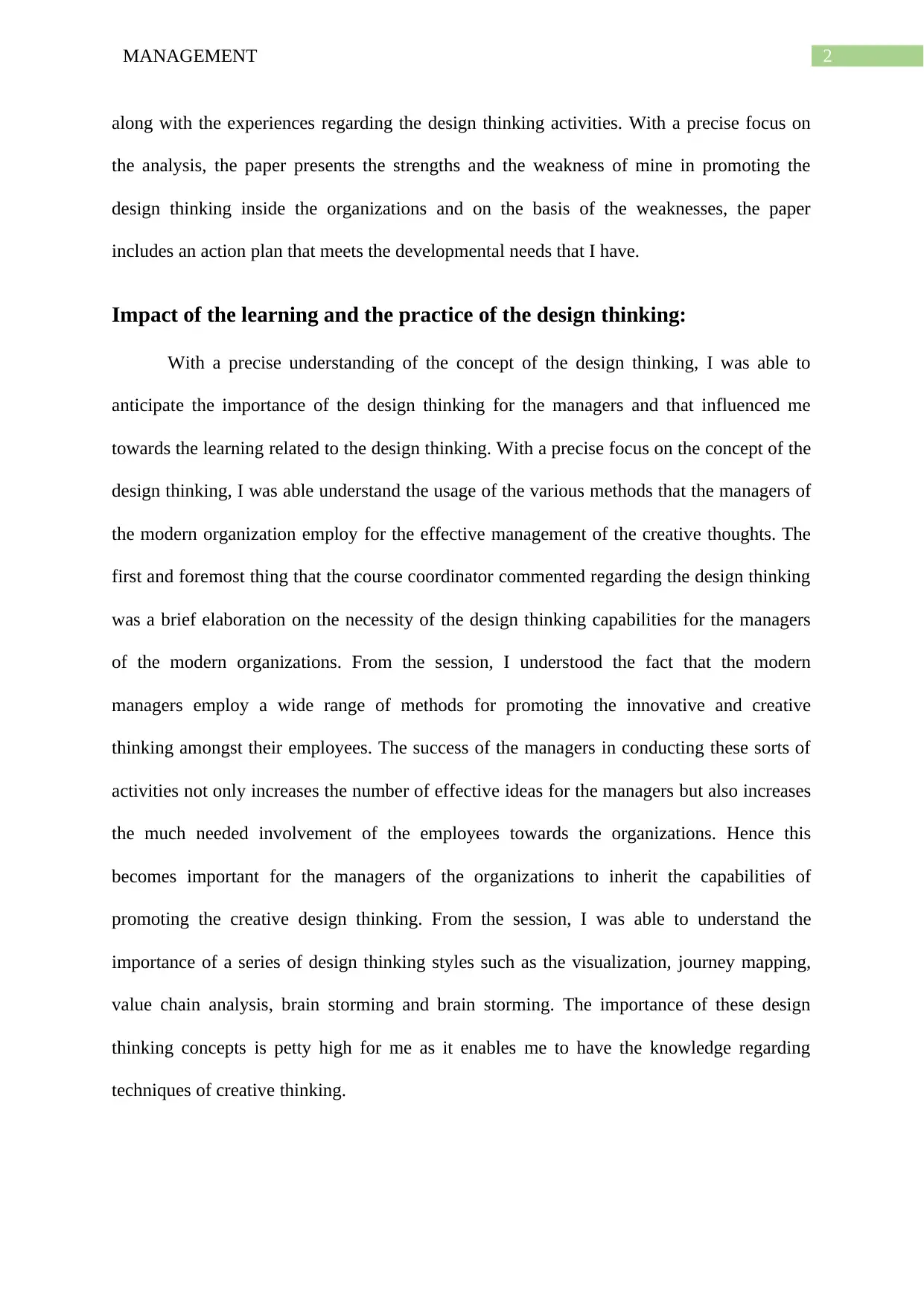
2MANAGEMENT
along with the experiences regarding the design thinking activities. With a precise focus on
the analysis, the paper presents the strengths and the weakness of mine in promoting the
design thinking inside the organizations and on the basis of the weaknesses, the paper
includes an action plan that meets the developmental needs that I have.
Impact of the learning and the practice of the design thinking:
With a precise understanding of the concept of the design thinking, I was able to
anticipate the importance of the design thinking for the managers and that influenced me
towards the learning related to the design thinking. With a precise focus on the concept of the
design thinking, I was able understand the usage of the various methods that the managers of
the modern organization employ for the effective management of the creative thoughts. The
first and foremost thing that the course coordinator commented regarding the design thinking
was a brief elaboration on the necessity of the design thinking capabilities for the managers
of the modern organizations. From the session, I understood the fact that the modern
managers employ a wide range of methods for promoting the innovative and creative
thinking amongst their employees. The success of the managers in conducting these sorts of
activities not only increases the number of effective ideas for the managers but also increases
the much needed involvement of the employees towards the organizations. Hence this
becomes important for the managers of the organizations to inherit the capabilities of
promoting the creative design thinking. From the session, I was able to understand the
importance of a series of design thinking styles such as the visualization, journey mapping,
value chain analysis, brain storming and brain storming. The importance of these design
thinking concepts is petty high for me as it enables me to have the knowledge regarding
techniques of creative thinking.
along with the experiences regarding the design thinking activities. With a precise focus on
the analysis, the paper presents the strengths and the weakness of mine in promoting the
design thinking inside the organizations and on the basis of the weaknesses, the paper
includes an action plan that meets the developmental needs that I have.
Impact of the learning and the practice of the design thinking:
With a precise understanding of the concept of the design thinking, I was able to
anticipate the importance of the design thinking for the managers and that influenced me
towards the learning related to the design thinking. With a precise focus on the concept of the
design thinking, I was able understand the usage of the various methods that the managers of
the modern organization employ for the effective management of the creative thoughts. The
first and foremost thing that the course coordinator commented regarding the design thinking
was a brief elaboration on the necessity of the design thinking capabilities for the managers
of the modern organizations. From the session, I understood the fact that the modern
managers employ a wide range of methods for promoting the innovative and creative
thinking amongst their employees. The success of the managers in conducting these sorts of
activities not only increases the number of effective ideas for the managers but also increases
the much needed involvement of the employees towards the organizations. Hence this
becomes important for the managers of the organizations to inherit the capabilities of
promoting the creative design thinking. From the session, I was able to understand the
importance of a series of design thinking styles such as the visualization, journey mapping,
value chain analysis, brain storming and brain storming. The importance of these design
thinking concepts is petty high for me as it enables me to have the knowledge regarding
techniques of creative thinking.
⊘ This is a preview!⊘
Do you want full access?
Subscribe today to unlock all pages.

Trusted by 1+ million students worldwide
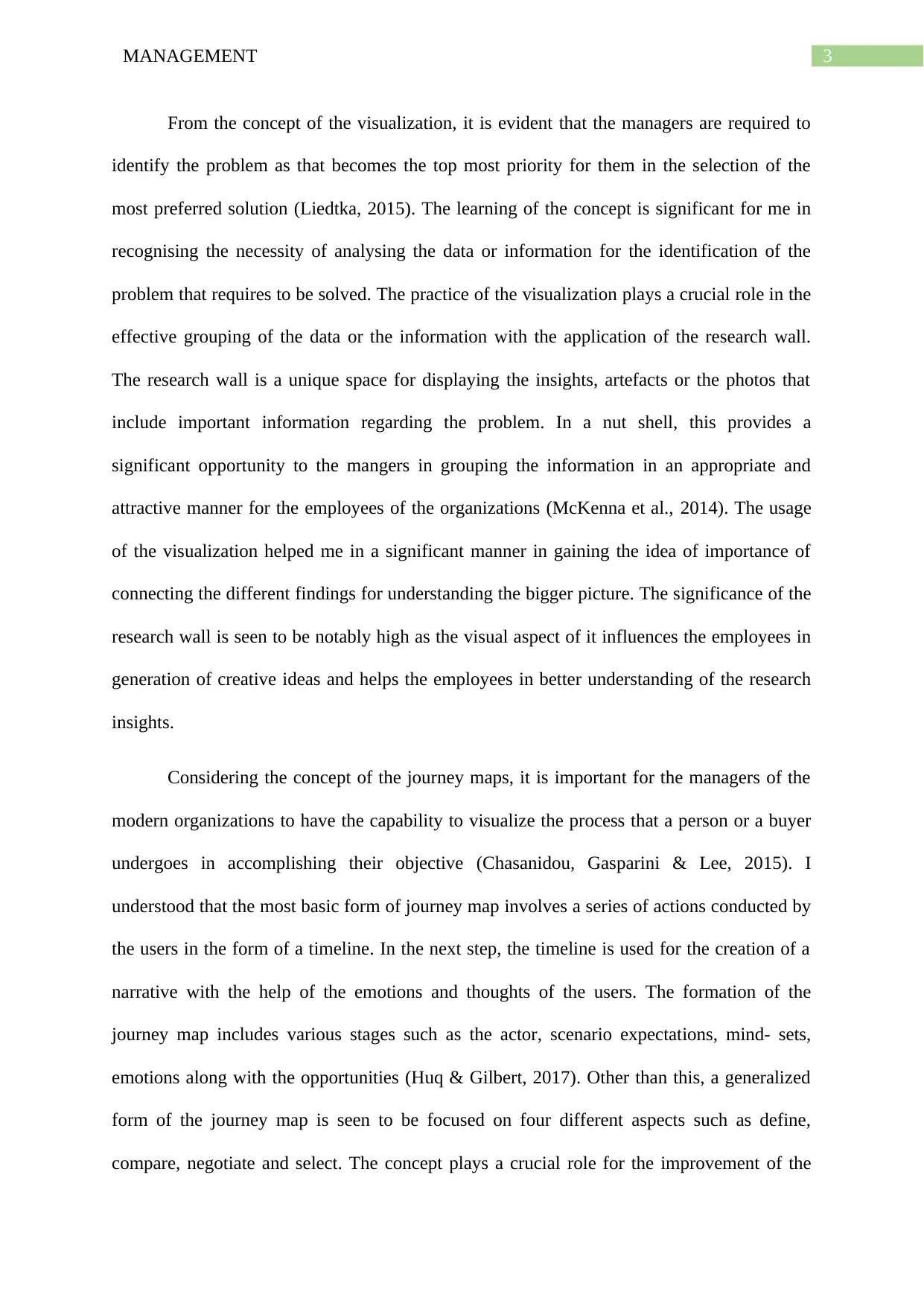
3MANAGEMENT
From the concept of the visualization, it is evident that the managers are required to
identify the problem as that becomes the top most priority for them in the selection of the
most preferred solution (Liedtka, 2015). The learning of the concept is significant for me in
recognising the necessity of analysing the data or information for the identification of the
problem that requires to be solved. The practice of the visualization plays a crucial role in the
effective grouping of the data or the information with the application of the research wall.
The research wall is a unique space for displaying the insights, artefacts or the photos that
include important information regarding the problem. In a nut shell, this provides a
significant opportunity to the mangers in grouping the information in an appropriate and
attractive manner for the employees of the organizations (McKenna et al., 2014). The usage
of the visualization helped me in a significant manner in gaining the idea of importance of
connecting the different findings for understanding the bigger picture. The significance of the
research wall is seen to be notably high as the visual aspect of it influences the employees in
generation of creative ideas and helps the employees in better understanding of the research
insights.
Considering the concept of the journey maps, it is important for the managers of the
modern organizations to have the capability to visualize the process that a person or a buyer
undergoes in accomplishing their objective (Chasanidou, Gasparini & Lee, 2015). I
understood that the most basic form of journey map involves a series of actions conducted by
the users in the form of a timeline. In the next step, the timeline is used for the creation of a
narrative with the help of the emotions and thoughts of the users. The formation of the
journey map includes various stages such as the actor, scenario expectations, mind- sets,
emotions along with the opportunities (Huq & Gilbert, 2017). Other than this, a generalized
form of the journey map is seen to be focused on four different aspects such as define,
compare, negotiate and select. The concept plays a crucial role for the improvement of the
From the concept of the visualization, it is evident that the managers are required to
identify the problem as that becomes the top most priority for them in the selection of the
most preferred solution (Liedtka, 2015). The learning of the concept is significant for me in
recognising the necessity of analysing the data or information for the identification of the
problem that requires to be solved. The practice of the visualization plays a crucial role in the
effective grouping of the data or the information with the application of the research wall.
The research wall is a unique space for displaying the insights, artefacts or the photos that
include important information regarding the problem. In a nut shell, this provides a
significant opportunity to the mangers in grouping the information in an appropriate and
attractive manner for the employees of the organizations (McKenna et al., 2014). The usage
of the visualization helped me in a significant manner in gaining the idea of importance of
connecting the different findings for understanding the bigger picture. The significance of the
research wall is seen to be notably high as the visual aspect of it influences the employees in
generation of creative ideas and helps the employees in better understanding of the research
insights.
Considering the concept of the journey maps, it is important for the managers of the
modern organizations to have the capability to visualize the process that a person or a buyer
undergoes in accomplishing their objective (Chasanidou, Gasparini & Lee, 2015). I
understood that the most basic form of journey map involves a series of actions conducted by
the users in the form of a timeline. In the next step, the timeline is used for the creation of a
narrative with the help of the emotions and thoughts of the users. The formation of the
journey map includes various stages such as the actor, scenario expectations, mind- sets,
emotions along with the opportunities (Huq & Gilbert, 2017). Other than this, a generalized
form of the journey map is seen to be focused on four different aspects such as define,
compare, negotiate and select. The concept plays a crucial role for the improvement of the
Paraphrase This Document
Need a fresh take? Get an instant paraphrase of this document with our AI Paraphraser
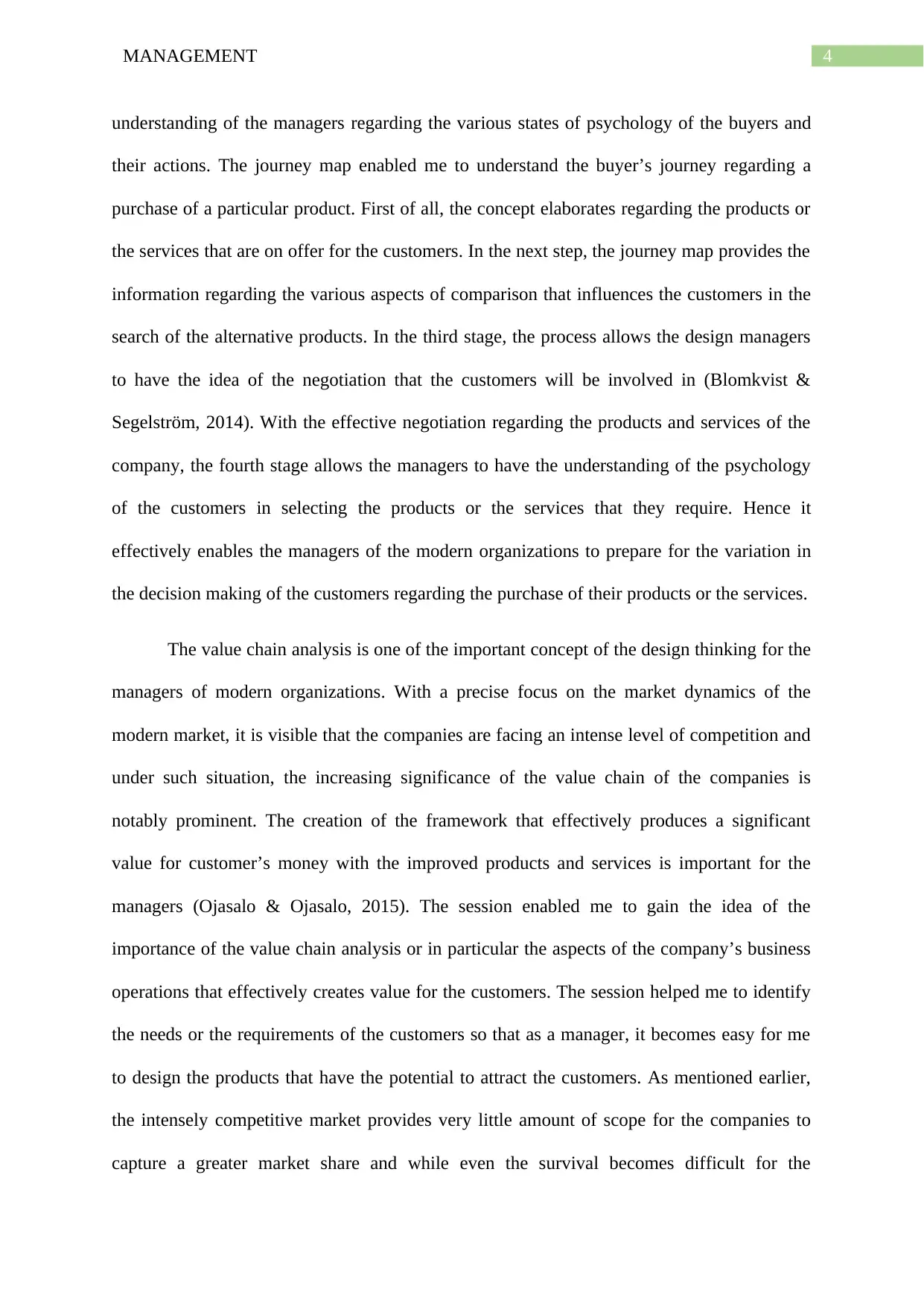
4MANAGEMENT
understanding of the managers regarding the various states of psychology of the buyers and
their actions. The journey map enabled me to understand the buyer’s journey regarding a
purchase of a particular product. First of all, the concept elaborates regarding the products or
the services that are on offer for the customers. In the next step, the journey map provides the
information regarding the various aspects of comparison that influences the customers in the
search of the alternative products. In the third stage, the process allows the design managers
to have the idea of the negotiation that the customers will be involved in (Blomkvist &
Segelström, 2014). With the effective negotiation regarding the products and services of the
company, the fourth stage allows the managers to have the understanding of the psychology
of the customers in selecting the products or the services that they require. Hence it
effectively enables the managers of the modern organizations to prepare for the variation in
the decision making of the customers regarding the purchase of their products or the services.
The value chain analysis is one of the important concept of the design thinking for the
managers of modern organizations. With a precise focus on the market dynamics of the
modern market, it is visible that the companies are facing an intense level of competition and
under such situation, the increasing significance of the value chain of the companies is
notably prominent. The creation of the framework that effectively produces a significant
value for customer’s money with the improved products and services is important for the
managers (Ojasalo & Ojasalo, 2015). The session enabled me to gain the idea of the
importance of the value chain analysis or in particular the aspects of the company’s business
operations that effectively creates value for the customers. The session helped me to identify
the needs or the requirements of the customers so that as a manager, it becomes easy for me
to design the products that have the potential to attract the customers. As mentioned earlier,
the intensely competitive market provides very little amount of scope for the companies to
capture a greater market share and while even the survival becomes difficult for the
understanding of the managers regarding the various states of psychology of the buyers and
their actions. The journey map enabled me to understand the buyer’s journey regarding a
purchase of a particular product. First of all, the concept elaborates regarding the products or
the services that are on offer for the customers. In the next step, the journey map provides the
information regarding the various aspects of comparison that influences the customers in the
search of the alternative products. In the third stage, the process allows the design managers
to have the idea of the negotiation that the customers will be involved in (Blomkvist &
Segelström, 2014). With the effective negotiation regarding the products and services of the
company, the fourth stage allows the managers to have the understanding of the psychology
of the customers in selecting the products or the services that they require. Hence it
effectively enables the managers of the modern organizations to prepare for the variation in
the decision making of the customers regarding the purchase of their products or the services.
The value chain analysis is one of the important concept of the design thinking for the
managers of modern organizations. With a precise focus on the market dynamics of the
modern market, it is visible that the companies are facing an intense level of competition and
under such situation, the increasing significance of the value chain of the companies is
notably prominent. The creation of the framework that effectively produces a significant
value for customer’s money with the improved products and services is important for the
managers (Ojasalo & Ojasalo, 2015). The session enabled me to gain the idea of the
importance of the value chain analysis or in particular the aspects of the company’s business
operations that effectively creates value for the customers. The session helped me to identify
the needs or the requirements of the customers so that as a manager, it becomes easy for me
to design the products that have the potential to attract the customers. As mentioned earlier,
the intensely competitive market provides very little amount of scope for the companies to
capture a greater market share and while even the survival becomes difficult for the
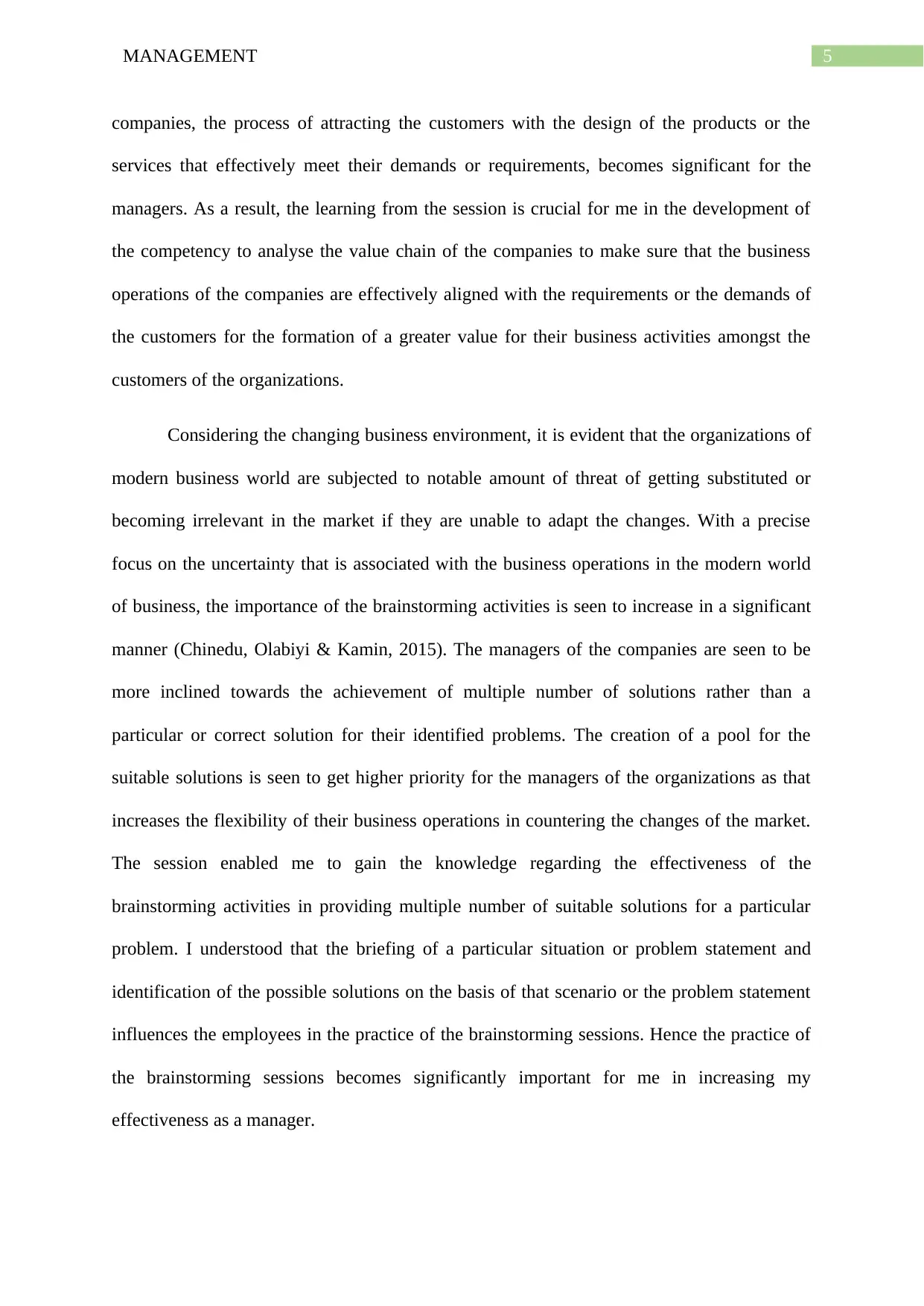
5MANAGEMENT
companies, the process of attracting the customers with the design of the products or the
services that effectively meet their demands or requirements, becomes significant for the
managers. As a result, the learning from the session is crucial for me in the development of
the competency to analyse the value chain of the companies to make sure that the business
operations of the companies are effectively aligned with the requirements or the demands of
the customers for the formation of a greater value for their business activities amongst the
customers of the organizations.
Considering the changing business environment, it is evident that the organizations of
modern business world are subjected to notable amount of threat of getting substituted or
becoming irrelevant in the market if they are unable to adapt the changes. With a precise
focus on the uncertainty that is associated with the business operations in the modern world
of business, the importance of the brainstorming activities is seen to increase in a significant
manner (Chinedu, Olabiyi & Kamin, 2015). The managers of the companies are seen to be
more inclined towards the achievement of multiple number of solutions rather than a
particular or correct solution for their identified problems. The creation of a pool for the
suitable solutions is seen to get higher priority for the managers of the organizations as that
increases the flexibility of their business operations in countering the changes of the market.
The session enabled me to gain the knowledge regarding the effectiveness of the
brainstorming activities in providing multiple number of suitable solutions for a particular
problem. I understood that the briefing of a particular situation or problem statement and
identification of the possible solutions on the basis of that scenario or the problem statement
influences the employees in the practice of the brainstorming sessions. Hence the practice of
the brainstorming sessions becomes significantly important for me in increasing my
effectiveness as a manager.
companies, the process of attracting the customers with the design of the products or the
services that effectively meet their demands or requirements, becomes significant for the
managers. As a result, the learning from the session is crucial for me in the development of
the competency to analyse the value chain of the companies to make sure that the business
operations of the companies are effectively aligned with the requirements or the demands of
the customers for the formation of a greater value for their business activities amongst the
customers of the organizations.
Considering the changing business environment, it is evident that the organizations of
modern business world are subjected to notable amount of threat of getting substituted or
becoming irrelevant in the market if they are unable to adapt the changes. With a precise
focus on the uncertainty that is associated with the business operations in the modern world
of business, the importance of the brainstorming activities is seen to increase in a significant
manner (Chinedu, Olabiyi & Kamin, 2015). The managers of the companies are seen to be
more inclined towards the achievement of multiple number of solutions rather than a
particular or correct solution for their identified problems. The creation of a pool for the
suitable solutions is seen to get higher priority for the managers of the organizations as that
increases the flexibility of their business operations in countering the changes of the market.
The session enabled me to gain the knowledge regarding the effectiveness of the
brainstorming activities in providing multiple number of suitable solutions for a particular
problem. I understood that the briefing of a particular situation or problem statement and
identification of the possible solutions on the basis of that scenario or the problem statement
influences the employees in the practice of the brainstorming sessions. Hence the practice of
the brainstorming sessions becomes significantly important for me in increasing my
effectiveness as a manager.
⊘ This is a preview!⊘
Do you want full access?
Subscribe today to unlock all pages.

Trusted by 1+ million students worldwide
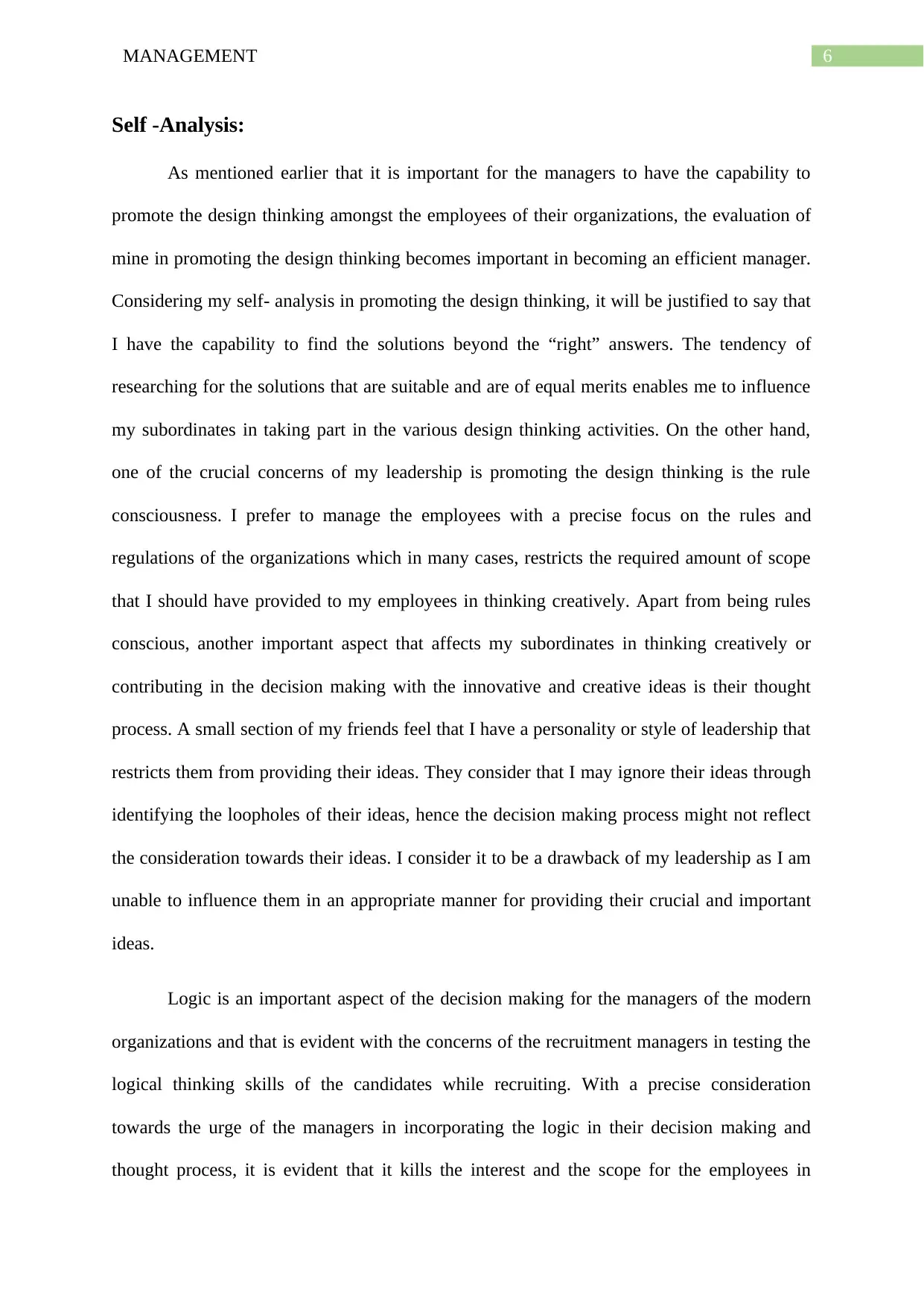
6MANAGEMENT
Self -Analysis:
As mentioned earlier that it is important for the managers to have the capability to
promote the design thinking amongst the employees of their organizations, the evaluation of
mine in promoting the design thinking becomes important in becoming an efficient manager.
Considering my self- analysis in promoting the design thinking, it will be justified to say that
I have the capability to find the solutions beyond the “right” answers. The tendency of
researching for the solutions that are suitable and are of equal merits enables me to influence
my subordinates in taking part in the various design thinking activities. On the other hand,
one of the crucial concerns of my leadership is promoting the design thinking is the rule
consciousness. I prefer to manage the employees with a precise focus on the rules and
regulations of the organizations which in many cases, restricts the required amount of scope
that I should have provided to my employees in thinking creatively. Apart from being rules
conscious, another important aspect that affects my subordinates in thinking creatively or
contributing in the decision making with the innovative and creative ideas is their thought
process. A small section of my friends feel that I have a personality or style of leadership that
restricts them from providing their ideas. They consider that I may ignore their ideas through
identifying the loopholes of their ideas, hence the decision making process might not reflect
the consideration towards their ideas. I consider it to be a drawback of my leadership as I am
unable to influence them in an appropriate manner for providing their crucial and important
ideas.
Logic is an important aspect of the decision making for the managers of the modern
organizations and that is evident with the concerns of the recruitment managers in testing the
logical thinking skills of the candidates while recruiting. With a precise consideration
towards the urge of the managers in incorporating the logic in their decision making and
thought process, it is evident that it kills the interest and the scope for the employees in
Self -Analysis:
As mentioned earlier that it is important for the managers to have the capability to
promote the design thinking amongst the employees of their organizations, the evaluation of
mine in promoting the design thinking becomes important in becoming an efficient manager.
Considering my self- analysis in promoting the design thinking, it will be justified to say that
I have the capability to find the solutions beyond the “right” answers. The tendency of
researching for the solutions that are suitable and are of equal merits enables me to influence
my subordinates in taking part in the various design thinking activities. On the other hand,
one of the crucial concerns of my leadership is promoting the design thinking is the rule
consciousness. I prefer to manage the employees with a precise focus on the rules and
regulations of the organizations which in many cases, restricts the required amount of scope
that I should have provided to my employees in thinking creatively. Apart from being rules
conscious, another important aspect that affects my subordinates in thinking creatively or
contributing in the decision making with the innovative and creative ideas is their thought
process. A small section of my friends feel that I have a personality or style of leadership that
restricts them from providing their ideas. They consider that I may ignore their ideas through
identifying the loopholes of their ideas, hence the decision making process might not reflect
the consideration towards their ideas. I consider it to be a drawback of my leadership as I am
unable to influence them in an appropriate manner for providing their crucial and important
ideas.
Logic is an important aspect of the decision making for the managers of the modern
organizations and that is evident with the concerns of the recruitment managers in testing the
logical thinking skills of the candidates while recruiting. With a precise consideration
towards the urge of the managers in incorporating the logic in their decision making and
thought process, it is evident that it kills the interest and the scope for the employees in
Paraphrase This Document
Need a fresh take? Get an instant paraphrase of this document with our AI Paraphraser
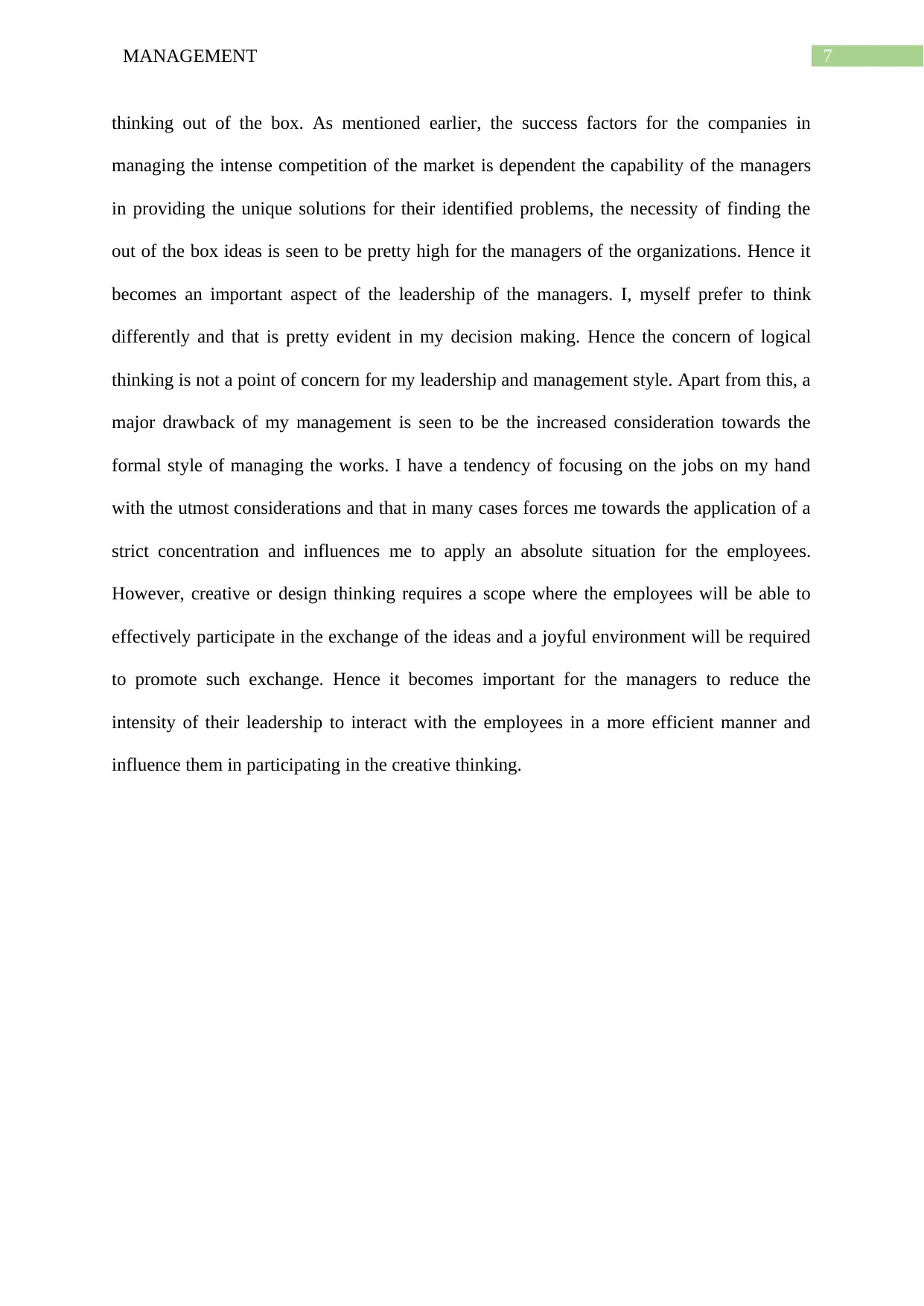
7MANAGEMENT
thinking out of the box. As mentioned earlier, the success factors for the companies in
managing the intense competition of the market is dependent the capability of the managers
in providing the unique solutions for their identified problems, the necessity of finding the
out of the box ideas is seen to be pretty high for the managers of the organizations. Hence it
becomes an important aspect of the leadership of the managers. I, myself prefer to think
differently and that is pretty evident in my decision making. Hence the concern of logical
thinking is not a point of concern for my leadership and management style. Apart from this, a
major drawback of my management is seen to be the increased consideration towards the
formal style of managing the works. I have a tendency of focusing on the jobs on my hand
with the utmost considerations and that in many cases forces me towards the application of a
strict concentration and influences me to apply an absolute situation for the employees.
However, creative or design thinking requires a scope where the employees will be able to
effectively participate in the exchange of the ideas and a joyful environment will be required
to promote such exchange. Hence it becomes important for the managers to reduce the
intensity of their leadership to interact with the employees in a more efficient manner and
influence them in participating in the creative thinking.
thinking out of the box. As mentioned earlier, the success factors for the companies in
managing the intense competition of the market is dependent the capability of the managers
in providing the unique solutions for their identified problems, the necessity of finding the
out of the box ideas is seen to be pretty high for the managers of the organizations. Hence it
becomes an important aspect of the leadership of the managers. I, myself prefer to think
differently and that is pretty evident in my decision making. Hence the concern of logical
thinking is not a point of concern for my leadership and management style. Apart from this, a
major drawback of my management is seen to be the increased consideration towards the
formal style of managing the works. I have a tendency of focusing on the jobs on my hand
with the utmost considerations and that in many cases forces me towards the application of a
strict concentration and influences me to apply an absolute situation for the employees.
However, creative or design thinking requires a scope where the employees will be able to
effectively participate in the exchange of the ideas and a joyful environment will be required
to promote such exchange. Hence it becomes important for the managers to reduce the
intensity of their leadership to interact with the employees in a more efficient manner and
influence them in participating in the creative thinking.
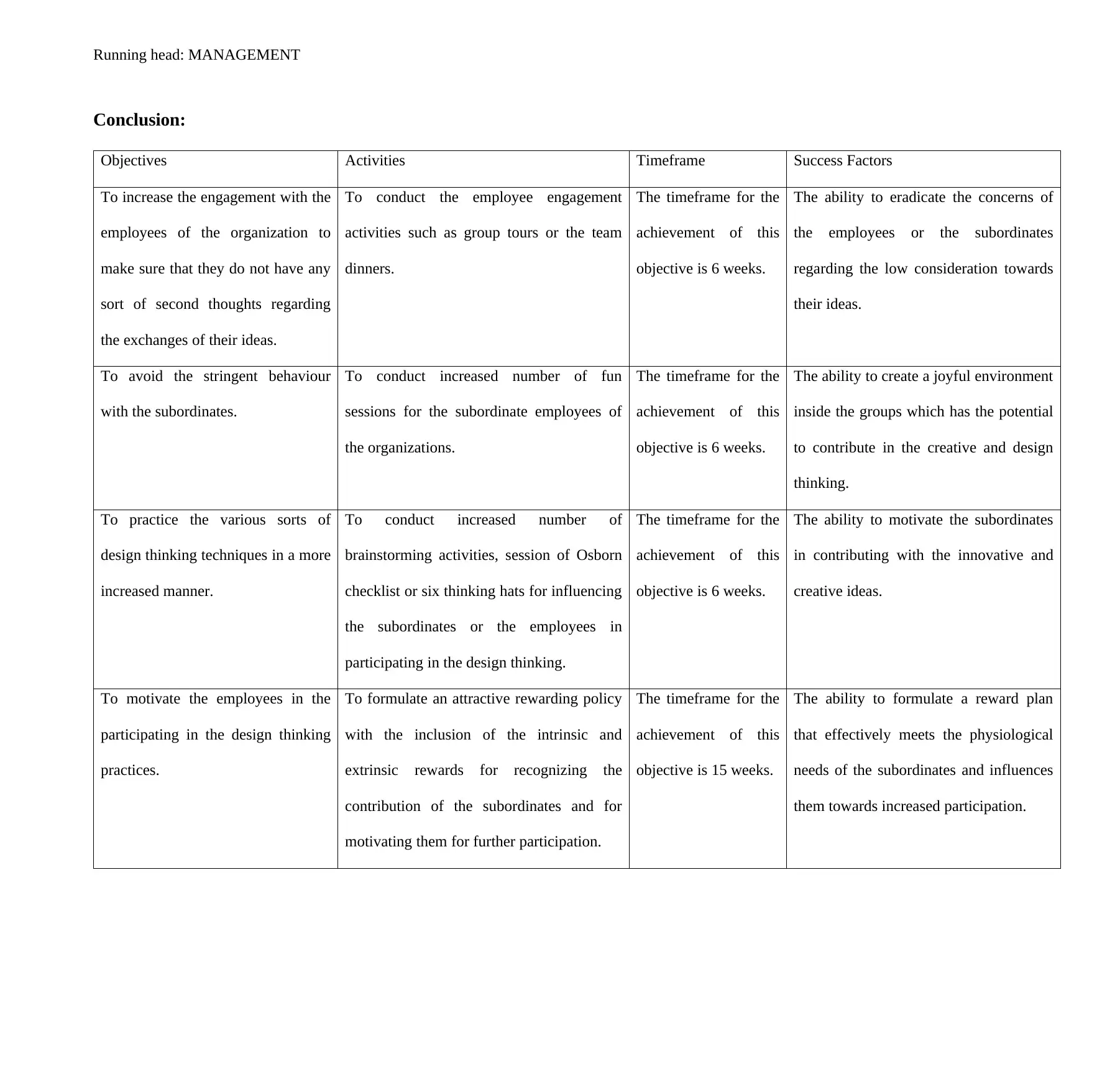
Running head: MANAGEMENT
Conclusion:
Objectives Activities Timeframe Success Factors
To increase the engagement with the
employees of the organization to
make sure that they do not have any
sort of second thoughts regarding
the exchanges of their ideas.
To conduct the employee engagement
activities such as group tours or the team
dinners.
The timeframe for the
achievement of this
objective is 6 weeks.
The ability to eradicate the concerns of
the employees or the subordinates
regarding the low consideration towards
their ideas.
To avoid the stringent behaviour
with the subordinates.
To conduct increased number of fun
sessions for the subordinate employees of
the organizations.
The timeframe for the
achievement of this
objective is 6 weeks.
The ability to create a joyful environment
inside the groups which has the potential
to contribute in the creative and design
thinking.
To practice the various sorts of
design thinking techniques in a more
increased manner.
To conduct increased number of
brainstorming activities, session of Osborn
checklist or six thinking hats for influencing
the subordinates or the employees in
participating in the design thinking.
The timeframe for the
achievement of this
objective is 6 weeks.
The ability to motivate the subordinates
in contributing with the innovative and
creative ideas.
To motivate the employees in the
participating in the design thinking
practices.
To formulate an attractive rewarding policy
with the inclusion of the intrinsic and
extrinsic rewards for recognizing the
contribution of the subordinates and for
motivating them for further participation.
The timeframe for the
achievement of this
objective is 15 weeks.
The ability to formulate a reward plan
that effectively meets the physiological
needs of the subordinates and influences
them towards increased participation.
Conclusion:
Objectives Activities Timeframe Success Factors
To increase the engagement with the
employees of the organization to
make sure that they do not have any
sort of second thoughts regarding
the exchanges of their ideas.
To conduct the employee engagement
activities such as group tours or the team
dinners.
The timeframe for the
achievement of this
objective is 6 weeks.
The ability to eradicate the concerns of
the employees or the subordinates
regarding the low consideration towards
their ideas.
To avoid the stringent behaviour
with the subordinates.
To conduct increased number of fun
sessions for the subordinate employees of
the organizations.
The timeframe for the
achievement of this
objective is 6 weeks.
The ability to create a joyful environment
inside the groups which has the potential
to contribute in the creative and design
thinking.
To practice the various sorts of
design thinking techniques in a more
increased manner.
To conduct increased number of
brainstorming activities, session of Osborn
checklist or six thinking hats for influencing
the subordinates or the employees in
participating in the design thinking.
The timeframe for the
achievement of this
objective is 6 weeks.
The ability to motivate the subordinates
in contributing with the innovative and
creative ideas.
To motivate the employees in the
participating in the design thinking
practices.
To formulate an attractive rewarding policy
with the inclusion of the intrinsic and
extrinsic rewards for recognizing the
contribution of the subordinates and for
motivating them for further participation.
The timeframe for the
achievement of this
objective is 15 weeks.
The ability to formulate a reward plan
that effectively meets the physiological
needs of the subordinates and influences
them towards increased participation.
⊘ This is a preview!⊘
Do you want full access?
Subscribe today to unlock all pages.

Trusted by 1+ million students worldwide
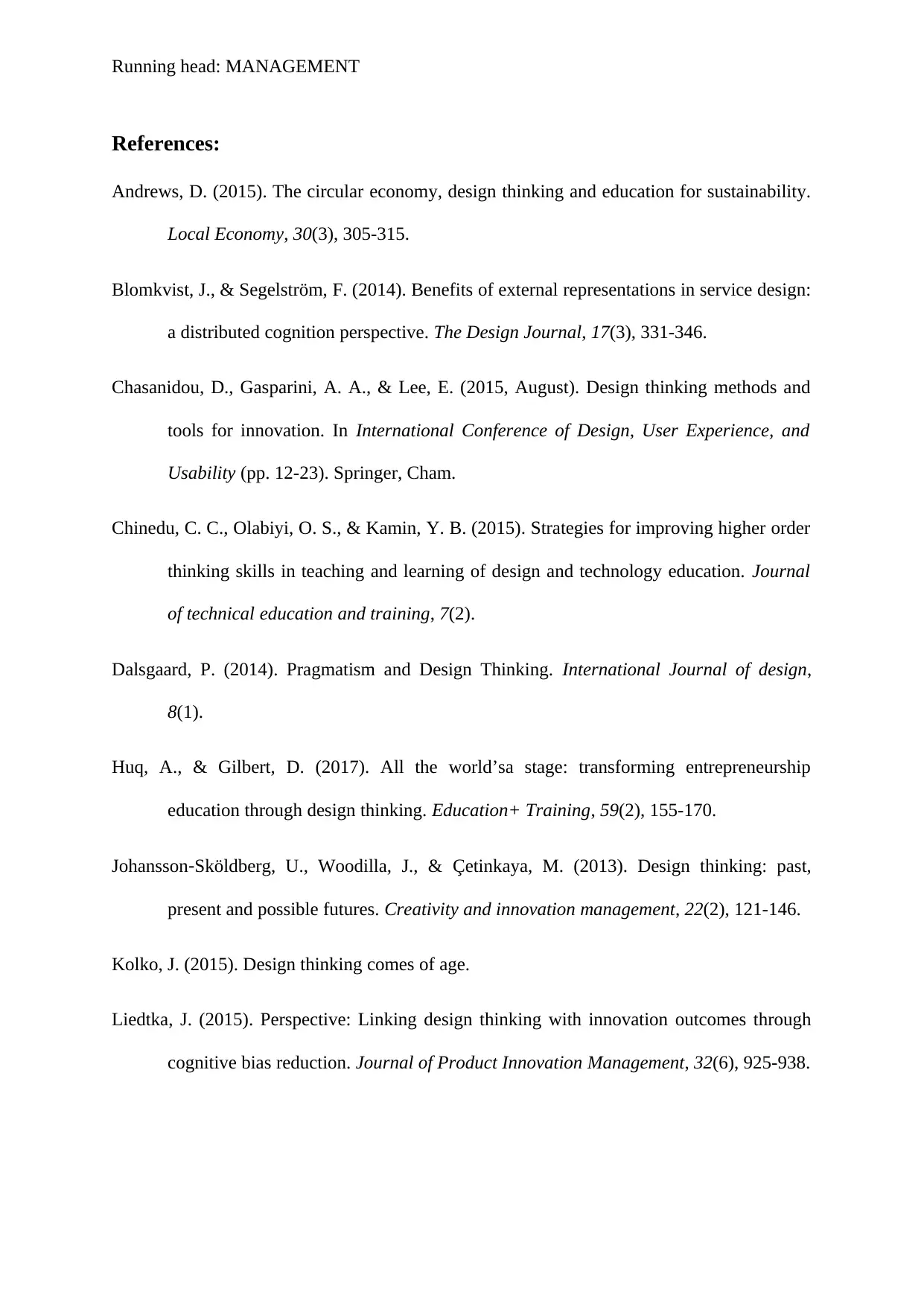
Running head: MANAGEMENT
References:
Andrews, D. (2015). The circular economy, design thinking and education for sustainability.
Local Economy, 30(3), 305-315.
Blomkvist, J., & Segelström, F. (2014). Benefits of external representations in service design:
a distributed cognition perspective. The Design Journal, 17(3), 331-346.
Chasanidou, D., Gasparini, A. A., & Lee, E. (2015, August). Design thinking methods and
tools for innovation. In International Conference of Design, User Experience, and
Usability (pp. 12-23). Springer, Cham.
Chinedu, C. C., Olabiyi, O. S., & Kamin, Y. B. (2015). Strategies for improving higher order
thinking skills in teaching and learning of design and technology education. Journal
of technical education and training, 7(2).
Dalsgaard, P. (2014). Pragmatism and Design Thinking. International Journal of design,
8(1).
Huq, A., & Gilbert, D. (2017). All the world’sa stage: transforming entrepreneurship
education through design thinking. Education+ Training, 59(2), 155-170.
Johansson‐Sköldberg, U., Woodilla, J., & Çetinkaya, M. (2013). Design thinking: past,
present and possible futures. Creativity and innovation management, 22(2), 121-146.
Kolko, J. (2015). Design thinking comes of age.
Liedtka, J. (2015). Perspective: Linking design thinking with innovation outcomes through
cognitive bias reduction. Journal of Product Innovation Management, 32(6), 925-938.
References:
Andrews, D. (2015). The circular economy, design thinking and education for sustainability.
Local Economy, 30(3), 305-315.
Blomkvist, J., & Segelström, F. (2014). Benefits of external representations in service design:
a distributed cognition perspective. The Design Journal, 17(3), 331-346.
Chasanidou, D., Gasparini, A. A., & Lee, E. (2015, August). Design thinking methods and
tools for innovation. In International Conference of Design, User Experience, and
Usability (pp. 12-23). Springer, Cham.
Chinedu, C. C., Olabiyi, O. S., & Kamin, Y. B. (2015). Strategies for improving higher order
thinking skills in teaching and learning of design and technology education. Journal
of technical education and training, 7(2).
Dalsgaard, P. (2014). Pragmatism and Design Thinking. International Journal of design,
8(1).
Huq, A., & Gilbert, D. (2017). All the world’sa stage: transforming entrepreneurship
education through design thinking. Education+ Training, 59(2), 155-170.
Johansson‐Sköldberg, U., Woodilla, J., & Çetinkaya, M. (2013). Design thinking: past,
present and possible futures. Creativity and innovation management, 22(2), 121-146.
Kolko, J. (2015). Design thinking comes of age.
Liedtka, J. (2015). Perspective: Linking design thinking with innovation outcomes through
cognitive bias reduction. Journal of Product Innovation Management, 32(6), 925-938.
Paraphrase This Document
Need a fresh take? Get an instant paraphrase of this document with our AI Paraphraser
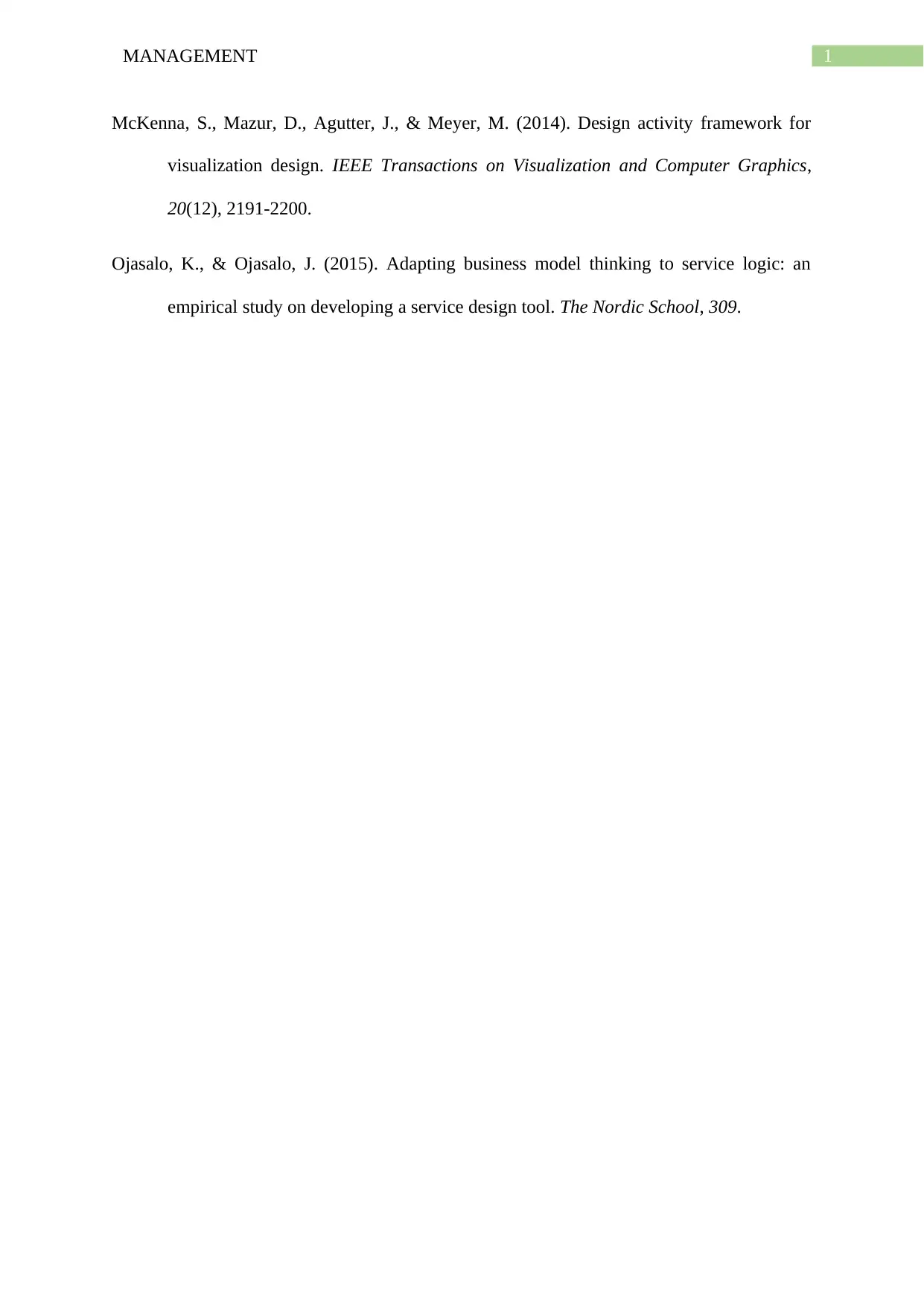
1MANAGEMENT
McKenna, S., Mazur, D., Agutter, J., & Meyer, M. (2014). Design activity framework for
visualization design. IEEE Transactions on Visualization and Computer Graphics,
20(12), 2191-2200.
Ojasalo, K., & Ojasalo, J. (2015). Adapting business model thinking to service logic: an
empirical study on developing a service design tool. The Nordic School, 309.
McKenna, S., Mazur, D., Agutter, J., & Meyer, M. (2014). Design activity framework for
visualization design. IEEE Transactions on Visualization and Computer Graphics,
20(12), 2191-2200.
Ojasalo, K., & Ojasalo, J. (2015). Adapting business model thinking to service logic: an
empirical study on developing a service design tool. The Nordic School, 309.
1 out of 11
Related Documents
Your All-in-One AI-Powered Toolkit for Academic Success.
+13062052269
info@desklib.com
Available 24*7 on WhatsApp / Email
![[object Object]](/_next/static/media/star-bottom.7253800d.svg)
Unlock your academic potential
Copyright © 2020–2025 A2Z Services. All Rights Reserved. Developed and managed by ZUCOL.





